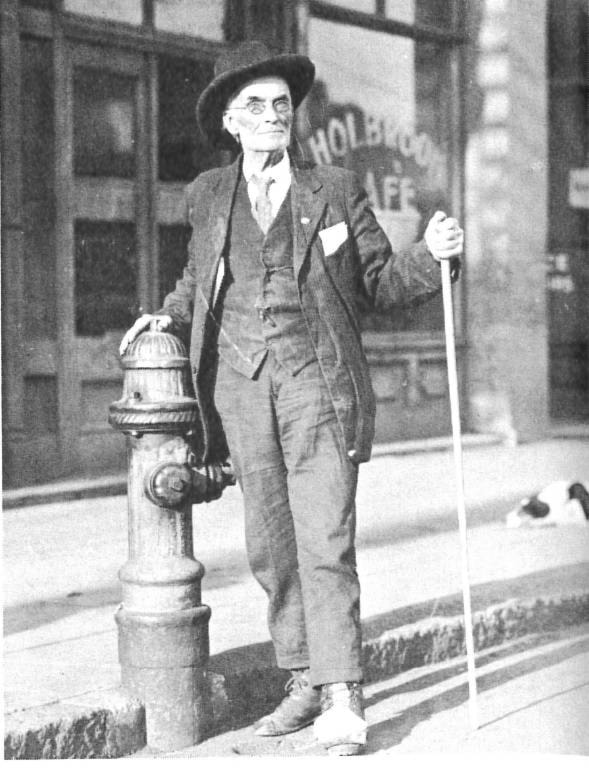A series on West Kootenay/Boundary place names
The explosive-sounding Boundary ghost town of Volcanic City was about ten miles up the Kettle River from Grand Forks and originally known as Brown’s Camp after Robert Allan Brown (1849-1931).
He was one of BC’s most colourful prospectors, nicknamed Crazy Brown, Sunset Brown, Doc Brown, and Volcanic Brown.
His early life is hazy, but he was born in New Brunswick and by his own account worked as a filer in a sawmill in Muskegon, Mich. when a strike was called in 1882 to protest 11-hour work days. Strikes of a different kind lured him west: he prospected either side of the Canadian Pacific Railway as it was built through BC and raced two others to a silver lode somewhere in the north.
“To head them off it was necessary for me to make most of the trip on snowshoes over an unsettled region, suffering the greatest hardships on the trip, but I arrived there three days before my rivals,” he recalled in 1917. “No deposit of silver, however, could be found.”
En route, he discovered what became the Volcanic mining claim on what’s unofficially known as Volcanic Mountain — so named because he believed that’s how it formed. It became his life’s work.
He said he staked the claim in 1882, but the earliest mention is in the Victoria Daily Colonist of July 15, 1892: “The principal prospect of Mr. Brown’s company is on Volcanic mountain, Kettle river.”
Brown’s Camp was first mentioned in the Midway Advance of Aug. 19, 1895 in a list of claims.
Brown’s nickname, which came from his unshakable faith in the mine, first appeared in the Nelson Tribune on Sept. 6, 1899, which referred to him as “R.A. Brown, known far and wide as Volcanic Brown.”
Volcanic City first appeared on a list of Boundary townsites in the Cascade Record of Aug. 26, 1899, but there were two places by that name — Brown’s, plus another about a mile away that submitted a post office application against Brown’s wishes. As a result, the name was changed to Toronto, then to Eagle City, but either way the town didn’t amount to much.
Brown didn’t promote his city in earnest until 1906, when a railway was planned up the north fork. At that point he applied for a hotel license and the Nelson Daily Canadian reported: “Volcanic Townsite is the very latest townsite to spring into existence. It is owned by R.A. Brown, of Volcanic mountain. The townsite has been plotted, and lots are already being sold. The Volcanic hotel is now opened, and William Rodia and Mike Scully, formerly business men of Nelson, have formed a partnership for the purpose of starting a large general merchandise store at Volcanic City.”
Supposedly Brown had deeds made out “that no church people or saloonmen shall be allowed to build on the lots.”
It’s not known who surveyed the townsite, if it actually happened. The plan doesn’t survive. Volcanic City never erupted into a bona fide town, but the name remained in use at least through 1927.
Brown steadfastly worked his mine alone, refusing offers to buy it, and by one account drove a tunnel 900 feet by hand. He never found anything worthwhile, yet never got discouraged. (He fared much better with the Sunset, a Similkameen copper mine. In 1899, he sold a half-interest for $40,000 — the equivalent of about $1.1 million today — so he could afford to chase a few mirages. He could also afford a set of gold teeth.)
In 1924, two boys took refuge in Volcanic Brown’s cabin from a violent neighbour named William Brown (no relation). In a drunken rage, William broke into the cabin, where Volcanic shot and killed him. Charged with manslaughter, Volcanic insisted he acted in self defence. With community sentiment strongly behind him, he was acquitted.
For six summers, Brown searched near Pitt Lake for a treasure known as Slumach’s lost mine. One one occasion, his foot froze and he amputated his own toes. But he was lucky to be rescued. On his final trip, his luck ran out. Although his camp was found, there was no trace of his body.
Brown and his phantom town are remembered in Volcanic Creek and Brown Creek — the former first mentioned in the Grand Forks Miner on April 3, 1897 and the latter in the Midway Advance 23 days later — as well as Volcanic Creek Road.
VIRGINIA CITY
This spot, also up the north fork of the Kettle River from Grand Forks, was only mentioned once, in the Cascade Record of Nov. 19, 1898: “A mile and a half north of the new town of Niagara, still another townsite has been surveyed and called Virginia City. It is near some mineral claims and there is also some heavy railroad work there … A two-storey hotel is already in the course of erection.”
Presumably it was named after the Virginia City in Montana or Nevada, mining centres both.
TUNNEL, REVISITED
A recent installment in this series claimed the last train on the Columbia and Western Railway was in 1988. Not so: Della Mallette points out it was actually in February 1991.
